Effects of Irrigation Projects on the Classification of Yellow River Terrace Landslides and their Failure Modes: A Case Study of Heitai Terrace
Abstract
:1. Introduction
2. Methods and Materials
2.1. Study Area
2.2. Numerical Analyses
2.3. Electrical Resistivity Tomography (ERT)
2.4. SBAS–InSAR
2.5. Field Investigation
3. Results
3.1. Type B1 Loess Landslides—Groundwater-Related
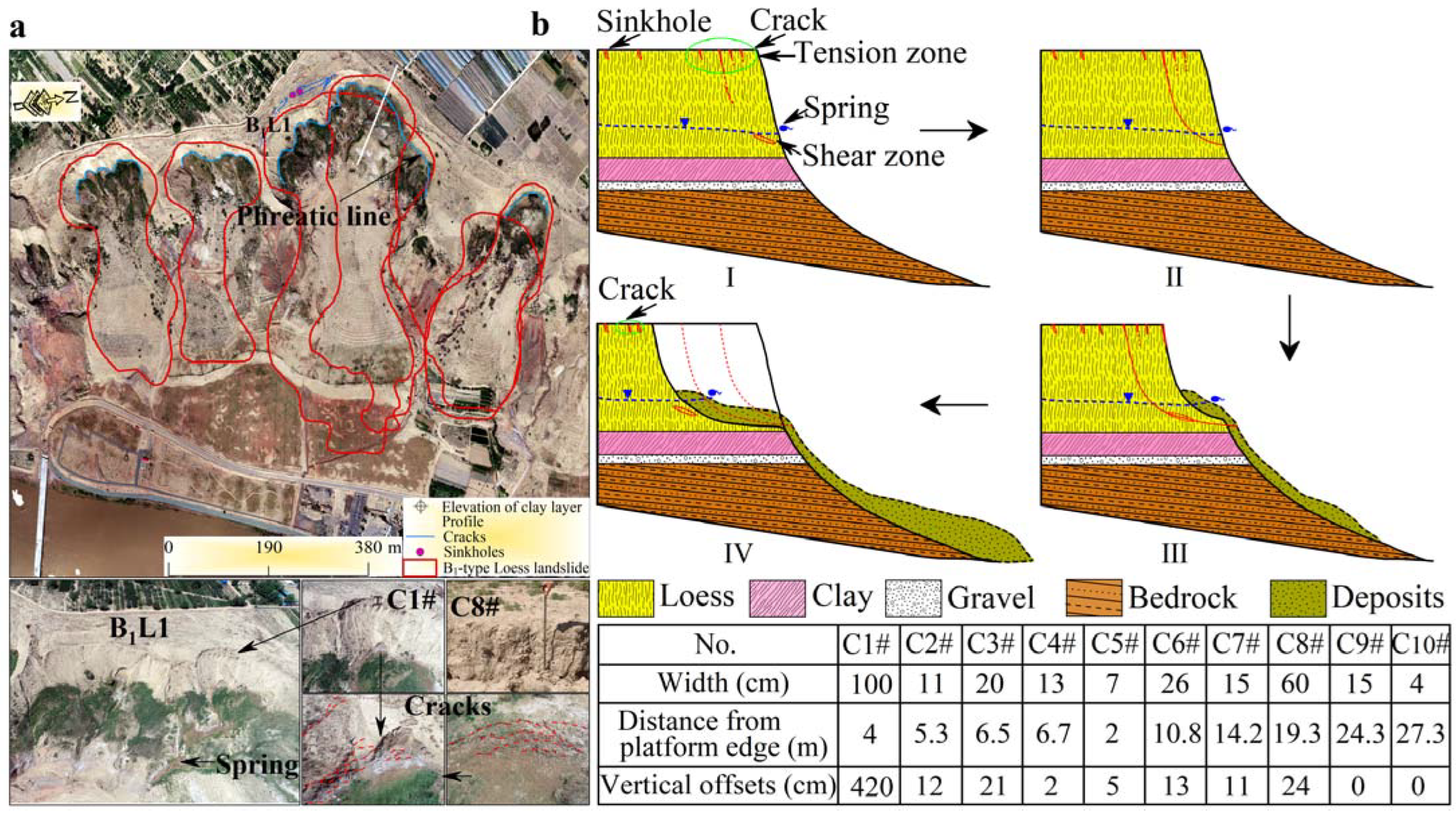
3.2. Type B2 Loess Landslides—Groundwater-Related
3.3. Type A Loess Landslides: Not Associated with Groundwater
3.4. Numerical Analyses
3.4.1. Variables: Groundwater Rise
3.4.2. Variables: Soil Strength Attenuation
3.4.3. Variables: Groundwater Rise and Soil Strength Attenuation
4. Discussion
4.1. Potential for Future Landslides on the Heitai Terrace
4.2. Conflict between Rapid Short-Term Geomorphological Evolution and Survival of the Local Population
5. Conclusions
Author Contributions
Funding
Data Availability Statement
Conflicts of Interest
References
- Varnes, D.J. Slope movement types and processes. Spec. Rep. 1978, 176, 11–33. [Google Scholar]
- Meng, X.M.; Derbyshire, E. Landslides and their control in the Chinese Loess Plateau: Models and case studies from Gansu Province, China. Geol. Soc. Lond. Eng. Geol. Spec. Publ. 1998, 15, 141–153. [Google Scholar] [CrossRef]
- Wang, Y.Z.; Zhou, L.C. Spatial distribution and mechanism of geological hazards along the oil pipeline planned in western China. Eng. Geol. 1999, 51, 195–201. [Google Scholar] [CrossRef]
- Hungr, O.; Leroueil, S.; Picarelli, L. The Varnes classification of landslide types, an update. Landslides 2014, 11, 167–194. [Google Scholar] [CrossRef]
- Xu, Q.; Li, Y.; Zhang, S.; Dong, X. Classification of large-scale landslides induced by the 2008 Wenchuan earthquake, China. Environ. Earth Sci. 2015, 75, 22. [Google Scholar] [CrossRef]
- Li, Y.; Mo, P. A unified landslide classification system for loess slopes: A critical review. Geomorphology 2019, 340, 67–83. [Google Scholar] [CrossRef]
- Peng, J.; Wang, S.; Wang, Q.; Zhuang, J.; Huang, W.; Zhu, X.; Ma, P. Distribution and genetic types of loess landslides in China. J. Asian Earth Sci. 2019, 170, 329–350. [Google Scholar] [CrossRef]
- Peng, J.; Wang, Q.Y.; Zhuang, J.Q.; Leng, Y.Q.; Fan, Z.J.; Wang, S.K. Dynamic formation mechanism of landslide disaster on the Loess Plateau. J. Geomech. 2020, 26, 714–730. (In Chinese) [Google Scholar]
- Li, P.; Qian, H.; Wu, J. Environment: Accelerate research on land creation. Nature 2014, 510, 29–31. [Google Scholar] [CrossRef]
- Juang, C.H.; Dijkstra, T.; Wasowski, J.; Meng, X. Loess geohazards research in China: Advances and challenges for mega engineering projects. Eng. Geol. 2019, 251, 1–10. [Google Scholar] [CrossRef]
- Jin, Z.; Peng, J.B.; Zhuang, J.Q.; Feng, L.; Huo, A.D.; Mu, X.M.; Wang, W.L. Gully erosion and expansion mechanisms in loess tablelands and the scientific basis of gully consolidation and tableland protection. Sci. Sin. 2023, 53, 806–822. (In Chinese) [Google Scholar] [CrossRef]
- Wang, J.; Xu, Y.; Ma, Y.; Qiao, S.; Feng, K. Study on the deformation and failure modes of filling slope in loess filling engineering: A case study at a loess mountain airport. Landslides 2018, 15, 2423–2435. [Google Scholar] [CrossRef]
- Peng, J.; Fan, Z.; Wu, D.; Huang, Q.; Wang, Q.; Zhuang, J.; Che, W. Landslides triggered by excavation in the loess plateau of China: A case study of Middle Pleistocene loess slopes. J. Asian Earth Sci. 2019, 171, 246–258. [Google Scholar] [CrossRef]
- Derbyshire, E. Geological hazards in loess terrain, with particular reference to the loess regions of China. Earth-Sci. Rev. 2001, 54, 231–260. [Google Scholar] [CrossRef]
- Xu, L.; Dai, C.F.; Kuang, G.L.; Min, H. Types and characteristics of loess landslides at Heifangtai Loess plateau China. Mt. Res. 2008, 3, 364–371. (In Chinese) [Google Scholar]
- Xu, L.; Dai, F.; Tu, X.; Tham, L.G.; Zhou, Y.; Iqbal, J. Landslides in a loess platform, North-West China. Landslides 2014, 11, 993–1005. [Google Scholar] [CrossRef]
- Pan, B.; Burbank, D.; Wang, Y.X.; Wu, G.J.; Li, J.J.; Guan, Q.Y. A 900 k.y. record of strath terrace formation during glacial-interglacial transitions in northwest china. Geology 2003, 31, 957–960. [Google Scholar] [CrossRef]
- Pan, B.T.; Huai, S.; Liu, X.F.; Hu, X.F.; Zhou, T.; Hu, C.S.; Li, J.J. River terraces of the Yellow river and their genesis in eastern Lanzhou basin during last 1.2 Ma. Quat. Sci. 2007, 2, 172–180. (In Chinese) [Google Scholar]
- Dong, Y.; Sun, P.P.; Zhang, M.S.; Chen, X.J.; Bi, J.B. The response of regional groundwater system to irrigation at Heifangtai terrace, Gansu province. Geol. Bull. China 2013, 32, 868–874. (In Chinese) [Google Scholar]
- Peng, D.; Xu, Q.; Liu, F.; He, Y.; Zhang, S.; Qi, X.; Zhang, X. Distribution and failure modes of the landslides in Heitai terrace, China. Eng. Geol. 2018, 236, 97–110. [Google Scholar] [CrossRef]
- Peng, D.; Xu, Q.; Zhang, X.; Xing, H.; Zhang, S.; Kang, K.; Zhao, K. Hydrological response of loess slopes with reference to widespread landslide events in the Heifangtai terrace, NW China. J. Asian Earth Sci. 2019, 171, 259–276. [Google Scholar] [CrossRef]
- Liu, X.; Zhao, C.; Zhang, Q.; Yang, C.; Zhu, W. Heifangtai loess landslide type and failure mode analysis with ascending and descending Spot-mode TerraSAR-X datasets. Landslides 2020, 17, 205–215. [Google Scholar] [CrossRef]
- Bian, S.; Chen, G.; Zeng, R.; Meng, X.; Jin, J.; Lin, L.; Shi, W. Post-failure evolution analysis of an irrigation-induced loess landslide using multiple remote sensing approaches integrated with time-lapse ERT imaging: Lessons from Heifangtai, China. Landslides 2022, 19, 1179–1197. [Google Scholar] [CrossRef]
- Fang, K.; Tang, H.; Li, C.; Su, X.; An, P.; Sun, S. Centrifuge modelling of landslides and landslide hazard mitigation: A review. Geosci. Front. 2022, 14, 101493. [Google Scholar] [CrossRef]
- Gu, T.F.; Zhang, M.S.; Wang, J.D.; Wang, C.X.; Xu, Y.J.; Wang, X. The effect of irrigation on slope stability in the Heifangtai Platform, Gansu Province, China. Eng. Geol. 2019, 248, 346–356. [Google Scholar] [CrossRef]
- Xu, L.; Dai, F.C.; Tham, L.G.; Tu, X.B.; Min, H.; Zhou, Y.F.; Xu, K. Field testing of irrigation effects on the stability of a cliff edge in loess, North-west China. Eng. Geol. 2011, 120, 10–17. [Google Scholar] [CrossRef]
- Dijkstra, T.A.; Rogers, C.D.F.; Smalley, I.J.; Derbyshire, E.; Li, Y.J.; Meng, X.M. The loess of north-central China: Geotechnical properties and their relation to slope stability. Eng. Geol. 1994, 36, 153–171. [Google Scholar] [CrossRef]
- Dijkstra, T.A.; Smalley, I.J.; Rogers, C.D.F. Particle packing in loess deposits and the problem of structure collapse and hydroconsolidation. Eng. Geol. 1995, 40, 49–64. [Google Scholar] [CrossRef]
- Zhang, M.; Liu, J. Controlling factors of loess landslides in western China. Environ. Earth Sci. 2010, 59, 1671–1680. [Google Scholar] [CrossRef]
- Tran, M.K.; Shin, H.; Byun, Y.H.; Lee, J.S. Mineral dissolution effects on mechanical strength. Eng. Geol. 2012, 125, 26–34. [Google Scholar] [CrossRef]
- Lian, B.Q.; Wang, X.G.; Zhang, H.B.; Wang, J.D.; Peng, J.B.; Gu, T.F.; Zhu, R.S. Creep mechanical and microstructural insights into the failure mechanism of loess landslides induced by dry-wet cycles in the Heifangtai platform, China. Eng. Geol. 2022, 300, 106589. [Google Scholar] [CrossRef]
- Havaee, S.; Mosaddeghi, M.R.; Ayoubi, S. In situ surface shear strength as affected by soil characteristics and land use in calcareous soils of central Iran. Geoderma 2015, 237–238, 137–148. [Google Scholar] [CrossRef]
- Xie, Q.; Huang, Q.; Liu, Y.; Wang, Z.; Yu, D.; Peng, J. Strength behaviors of undisturbed malan loess under rainfall leaching in yan’an area, china. Bull. Eng. Geol. Environ. 2023, 82, 53. [Google Scholar] [CrossRef]
- Kong, J.; Zhuang, J.; Peng, J.; Ma, P.; Zhan, J.; Mu, J.; Du, C. Failure mechanism and movement process of three loess landslides due to freeze-thaw cycle in the Fangtai village, Yongjing County, Chinese Loess Plateau. Eng. Geol. 2023, 315, 107030. [Google Scholar] [CrossRef]
- Zhang, Z.; Zeng, R.; Meng, X.; Zhang, Y.; Zhao, S.; Ma, J.; Yao, Y. Effect of soluble salt loss via spring water on irrigation-induced landslide deformation. Water 2020, 12, 2889. [Google Scholar] [CrossRef]
- Zhang, Z.; Zeng, R.; Meng, X.; Zhao, S.; Ma, J.; Wang, H.; He, B. Effects of material migration on the spatial distribution of topsoil moisture at the slope scale. Eng. Geol. 2022, 308, 106820. [Google Scholar] [CrossRef]
- Zhang, Z.; Zeng, R.; Meng, X.; Zhao, S.; Wang, S.; Ma, J.; Wang, H. Effects of changes in soil properties caused by progressive infiltration of rainwater on rainfall-induced landslides. Catena 2023, 233, 107475. [Google Scholar] [CrossRef]
- Peng, D. Study on early recognition for potentially loess landslide—A case study at Heifangtai terrace, Gansu Province, China. Lanzhou Univ. 2018. (In Chinese) [Google Scholar]
- Bi, Q.T.; Fan, X.X.; Dong, W.P. Shear Strength Characteristics of Remolded Loess by Ring Shear Apparatus. J. Water Resour. Archit. Eng. 2022, 20, 96–101. (In Chinese) [Google Scholar]
- Zhang, L.; Xu, Q.; Peng, D.L.; Zhao, K.Y.; Liu, L.; Ren, J. Application of high-density resistivity method to groundwater exploration in Heifangtai. Prog. Geophys. 2017, 32, 1862–1867. (In Chinese) [Google Scholar]
- Perrone, A.; Lapenna, V.; Piscitelli, S. Electrical resistivity tomography technique for landslide investigation: A review. Earth-Sci. Rev. 2014, 135, 65–82. [Google Scholar] [CrossRef]
- Shanker, P.; Casu, F.; Zebker, H.A.; Lanari, R. Comparison of persistent scatterers and small baseline time-series InSAR results: A case study of the San Francisco bay area. IEEE Geosci. Remote Sens. Lett. 2011, 8, 592–596. [Google Scholar] [CrossRef]
- Bayer, B.; Simoni, A.; Schmidt, D.; Bertello, L. Using advanced InSAR techniques to monitor landslide deformations induced by tunneling in the Northern Apennines, Italy. Eng. Geol. 2017, 226, 20–32. [Google Scholar] [CrossRef]
- Chen, Y.; Dong, X.; Qi, Y.; Huang, P.; Sun, W.; Xu, W.; Liu, X. Integration of DInSAR-PS-Stacking and SBAS-PS-InSAR Methods to Monitor Mining-Related Surface Subsidence. Remote Sens. 2023, 15, 2691. [Google Scholar] [CrossRef]
- Yao, J.; Yao, X.; Liu, X. Landslide detection and mapping based on SBAS-InSAR and PS-InSAR: A case study in Gongjue County, Tibet, China. Remote Sens. 2022, 14, 4728. [Google Scholar] [CrossRef]
- Ferretti, A.; Prati, C.; Rocca, F. Nonlinear subsidence rate estimation using permanent scatterers in differential SAR interferometry. IEEE Trans. Geosci. Remote Sens. 2000, 38, 2202–2212. [Google Scholar] [CrossRef]
- Ferretti, A.; Prati, C.; Rocca, F. Permanent scatterers in SAR interferometry. IEEE Trans. Geosci. Remote Sens. 2001, 39, 8–20. [Google Scholar] [CrossRef]
- Berardino, P.; Fornaro, G.; Lanari, R.; Sansosti, E. A new algorithm for surface deformation monitoring based on small baseline differential SAR interferograms. IEEE Trans. Geosci. Remote Sens. 2002, 40, 2375–2383. [Google Scholar] [CrossRef]
- Hooper, A.J. Persistent Scatter Radar Interferometry for Crustal Deformation Studies and Modeling of Volcanic Deformation. Ph.D. Thesis, Stanford University, Stanford, CA, USA, 2006. [Google Scholar]
- Gourmelen, N.; Amelung, F.; Casu, F.; Manzo, M.; Lanari, R. Mining-related ground deformation in Crescent Valley, Nevada: Implications for sparse GPS networks. Geophys. Res. Lett. 2007, 34. [Google Scholar] [CrossRef]
- Zhao, S.; Zeng, R.; Zhang, H.; Meng, X.; Zhang, Z.; Meng, X.; Liu, J. Impact of water level fluctuations on landslide deformation at Longyangxia reservoir, Qinghai province, China. Remote Sens. 2022, 14, 212. [Google Scholar] [CrossRef]
- Costantini, M.; Rosen, P.A. A generalized phase unwrap approach for sparse data. In Proceedings of the IEEE 1999 International Geoscience and Remote Sensing Symposium, IGARSS’99 (Cat. No. 99CH36293), Hamburg, Germany, 28 June–2 July 1999; Volume 1, pp. 267–269. [Google Scholar]
- Goldstein, R.M.; Werner, C.L. Radar interferogram filtering for geophysical applications. Geophys. Res. Lett. 1998, 25, 4035–4038. [Google Scholar] [CrossRef]
- Zhang, H.; Zeng, R.; Zhang, Y.; Zhao, S.; Meng, X.; Li, Y.; Yang, Y. Subsidence monitoring and influencing factor analysis of mountain excavation and valley infilling on the Chinese Loess Plateau: A case study of Yan’an New District. Eng. Geol. 2022, 297, 106482. [Google Scholar] [CrossRef]
- Liu, X.; Zhao, C.; Zhang, Q.; Peng, J.; Zhu, W.; Lu, Z. Multi-temporal loess landslide inventory mapping with C-, X-and L-band SAR datasets—A case study of Heifangtai loess landslides, China. Remote Sens. 2018, 10, 1756. [Google Scholar] [CrossRef]
- Liu, X.; Zhao, C.; Zhang, Q.; Lu, Z.; Dai, F. Investigating the Deformation History and Failure Mechanism of HEIFANGTAI Loess Landslide, China with Multi-Source SAR Data. In Proceedings of the IGARSS 2019–2019 IEEE International Geoscience and Remote Sensing Symposium, Yokohama, Japan, 28 July–2 August 2019; pp. 2074–2077. [Google Scholar]
- Shi, X.; Xu, Q.; Zhang, L.; Zhao, K.; Dong, J.; Jiang, H.; Liao, M. Surface displacements of the Heifangtai terrace in Northwest China measured by X and C-band InSAR observations. Eng. Geol. 2019, 259, 105181. [Google Scholar] [CrossRef]
- Nishiguchi, T.; Tsuchiya, S.; Imaizumi, F. Detection and accuracy of landslide movement by InSAR analysis using PALSAR-2 data. Landslides 2017, 14, 1483–1490. [Google Scholar] [CrossRef]
- Qi, X.; Xu, Q.; Peng, D.; Dong, X.; Tao, Y. Mechanism of gradual retrate loess landslide caused by groundwater: A case study of the irrigation loess landslide in Heifangtai, GanSu province. J. Eng. Geol. 2017, 25, 147–153. (In Chinese) [Google Scholar]
- Xu, Q.; Zhao, K.; Liu, F.; Peng, D.; Chen, W. Effects of land use on groundwater recharge of a loess terrace under long-term irrigation. Sci. Total Environ. 2021, 751, 142340. [Google Scholar] [CrossRef]
- Zhang, F.; Wang, G.; Peng, J. Initiation and mobility of recurring loess flowslides on the Heifangtai irrigated terrace in China: Insights from hydrogeological conditions and liquefaction criteria. Eng. Geol. 2022, 302, 106619. [Google Scholar] [CrossRef]
- Qi, X.; Xu, Q.; Liu, F.Z. Analysis of retrogressive loess flowslides in Heifangtai, China. Eng. Geol. 2018, 236, 119–128. [Google Scholar] [CrossRef]
- Jin, Y.L.; Dai, F.C. The mechanism of irrigation-induced landslides of loess. Chin. J. Geotech. Eng. 2007, 29, 1493–1499. (In Chinese) [Google Scholar]
- Bishop, A.W. Progressive failure-with special reference to the mechanism causing it. In Progressive Failure Analysis of Slopes Using Non-Vertical Slices; Norwegian Geotechnical Institute: Oslo, Norway, 1967; Volume 2, pp. 142–150. [Google Scholar]
- Vaid, Y.P.; Sivathayalan, S. Static and cyclic liquefaction potential of Fraser Delta sand in simple shear and triaxial tests. Can. Geotech. J. 1996, 33, 281–289. [Google Scholar] [CrossRef]
- Leroueil, S. Natural slopes and cuts: Movement and failure mechanisms. Géotechnique 2001, 51, 197–243. [Google Scholar] [CrossRef]
- Wang, G.; Sassa, K. Post-failure mobility of saturated sands in undrained load-controlled ring shear tests. Can. Geotech. J. 2002, 39, 821–837. [Google Scholar] [CrossRef]
- Zhou, F.; Xu, Q.; Ju, Y.Z.; Peng, D.L.; Yuan, X. A study of the deformation and failure mechanism of the Heifangtai loess slope. Hydrogeol. Eng. Geol. 2017, 44, 157–163. (In Chinese) [Google Scholar]
- Zhang, F.; Wang, G. Effect of irrigation-induced densification on the post-failure behavior of loess flowslides occurring on the Heifangtai area, Gansu, China. Eng. Geol. 2018, 236, 111–118. [Google Scholar] [CrossRef]
- Pan, P.; Shang, Y.Q.; Lü, Q.; Yu, Y. Periodic recurrence and scale-expansion mechanism of loess landslides caused by groundwater seepage and erosion. Bull. Eng. Geol. Environ. 2019, 78, 1143–1155. [Google Scholar] [CrossRef]
- Peng, D.; Xu, Q.; Qi, X.; Fan, X.; Dong, X.; Li, S.; Ju, Y. Study on early recognition of loess landslides based on field investigation. Int. J. Georesou. Environ. 2016, 2, 35–52. [Google Scholar] [CrossRef]
- Zhang, F.Y.; Wang, G.H.; Kamai, T.; Chen, W.W.; Zhang, D.X.; Yang, J. Undrained shear behavior of loess saturated with different concentrations of sodium chloride solution. Eng. Geol. 2013, 155, 69–79. [Google Scholar] [CrossRef]
- Yang, D.; Qiu, H.; Hu, S.; Zhu, Y.; Cui, Y.; Du, C.; Cao, M. Spatiotemporal distribution and evolution characteristics of successive landslides on the Heifangtai tableland of the Chinese Loess Plateau. Geomorphology 2021, 378, 107619. [Google Scholar] [CrossRef]
- Sun, P.P.; Zhang, M.S.; Zhu, L.F.; Xue, Q.; Hu, W. Typical case study of loess collapse and discussion on related problems. Geol. Bull. China 2013, 32, 847–851. (In Chinese) [Google Scholar]
- Zhang, H.; Dang, X.; Jia, L.; Zhao, J.; Fan, X.; Lu, M. Analysis and prediction of landslide subsidence characteristics of Dangchuan based on sentinel-1A data. In Proceedings of the International Conference on Neural Networks, Information, and Communication Engineering (NNICE), Qingdao, China, 25–27 March 2022; Volume 12258, pp. 345–352. [Google Scholar]
- Zhang, M.S. Formation mechanism as well as prevention and controlling techniques of loess geo-hazards in irrigated areas: A case study of Heifangtai immigration area in the Three Gorges Reservoir of the Yellow River. Geol. Bull. China 2013, 32, 833–839. (In Chinese) [Google Scholar]
- Gu, T.; Wang, J.; Lin, H.; Xue, Q.; Sun, B.; Kong, J.; Wang, X. The spatiotemporal relationship between landslides and mechanisms at the Heifangtai terrace, Northwest China. Water 2021, 13, 3275. [Google Scholar] [CrossRef]
- Zhang, Z.; Zeng, R.; Meng, X.; Zhao, S.; Meng, X.; Yao, Y.; Zhang, Y. Estimating landslide sliding distance based on an improved Heim sled model. Catena 2021, 204, 105401. [Google Scholar] [CrossRef]
- Wang, C.; Wang, H.; Qin, W.; Wei, S.; Tian, H.; Fang, K. Behaviour of pile-anchor reinforced landslides under varying water level, rainfall, and thrust load: Insight from physical modelling. Eng. Geol. 2023, 325, 107293. [Google Scholar] [CrossRef]
- Zhou, Q.; Xu, Q.; Peng, D.; Fan, X.; Ouyang, C.; Zhao, K.; Zhu, X. Quantitative spatial distribution model of site-specific loess landslides on the Heifangtai terrace, China. Landslides 2021, 18, 1163–1176. [Google Scholar] [CrossRef]
- Bălteanu, D.; Micu, M.; Jurchescu, M.; Malet, J.P.; Sima, M.; Kucsicsa, G.; Senzaconi, F. National-scale landslide susceptibility map of Romania in a European methodological framework. Geomorphology 2020, 371, 107432. [Google Scholar] [CrossRef]
- Sestraș, P.; Bilașco, Ș.; Roșca, S.; Naș, S.; Bondrea, M.V.; Gâlgău, R.; Cimpeanu, S.M. Landslides susceptibility assessment based on GIS statistical bivariate analysis in the hills surrounding a metropolitan area. Sustainability 2019, 11, 1362. [Google Scholar] [CrossRef]
- Sestras, P.; Bilașco, Ș.; Roșca, S.; Ilies, N.; Hysa, A.; Spalević, V.; Cîmpeanu, S.M. Multi-instrumental approach to slope failure monitoring in a landslide susceptible newly built-up area: Topo-Geodetic survey, UAV 2022, 3D modelling and ground-penetrating radar. Remote Sens. 2022, 14, 5822. [Google Scholar] [CrossRef]
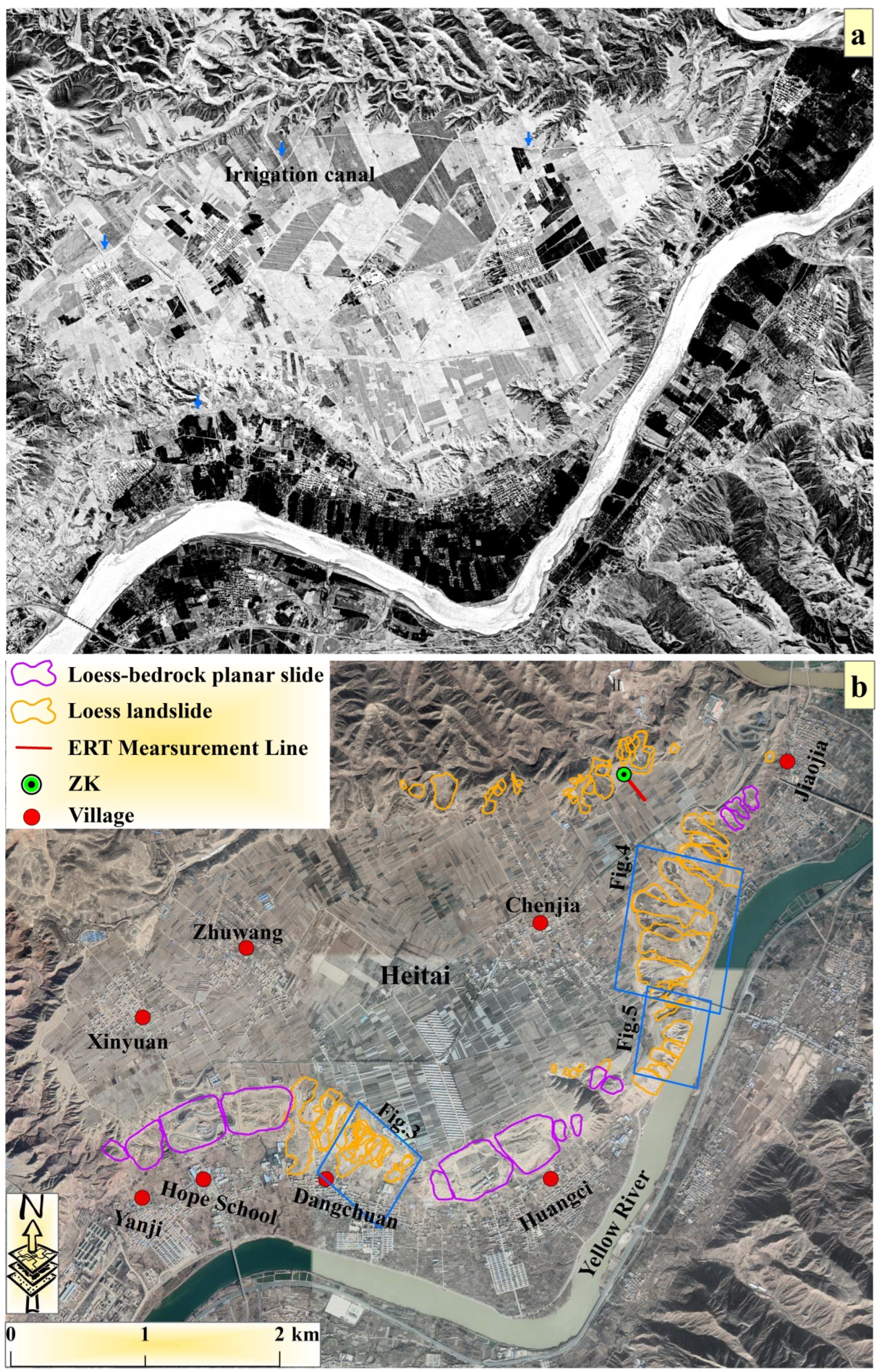
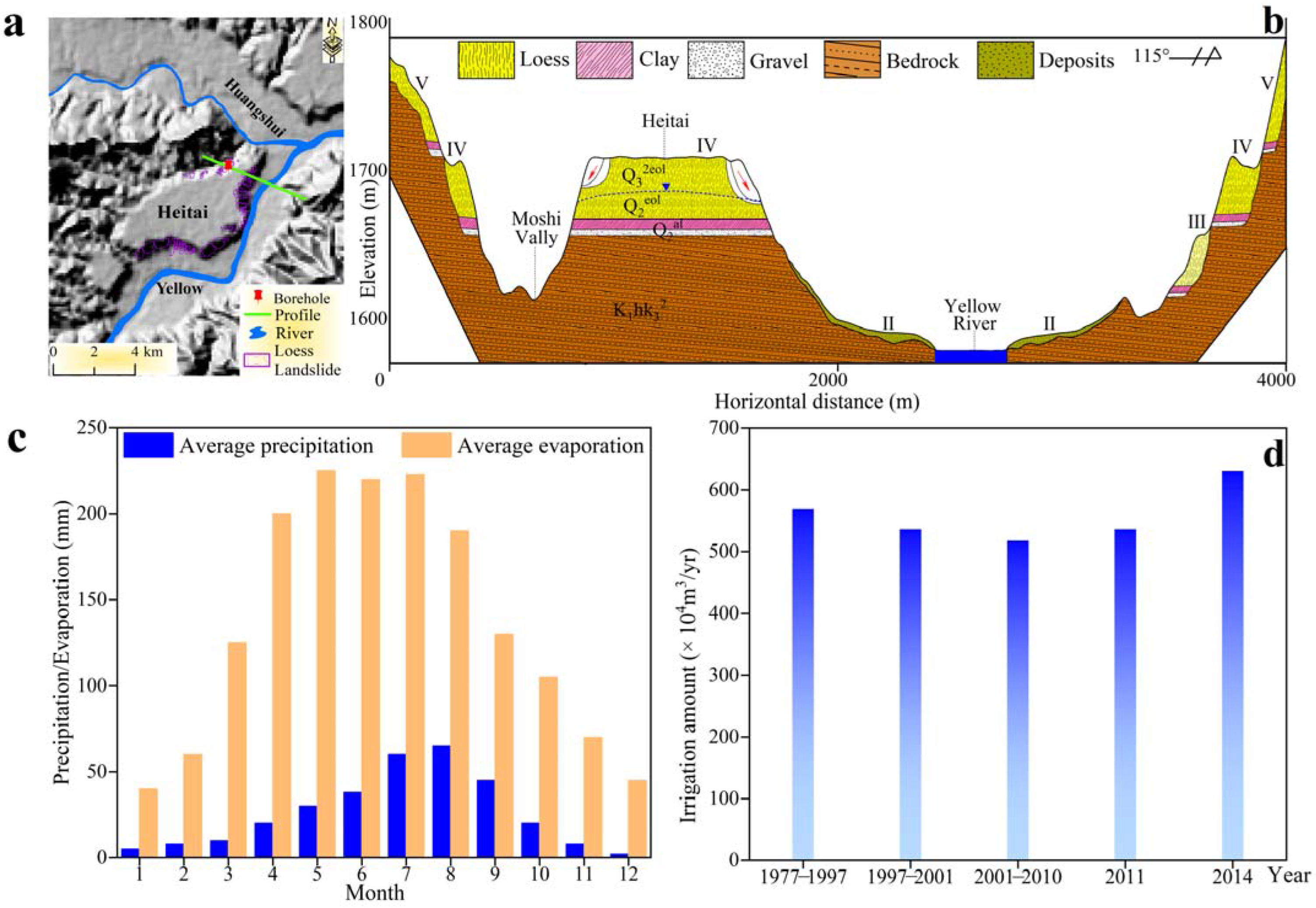

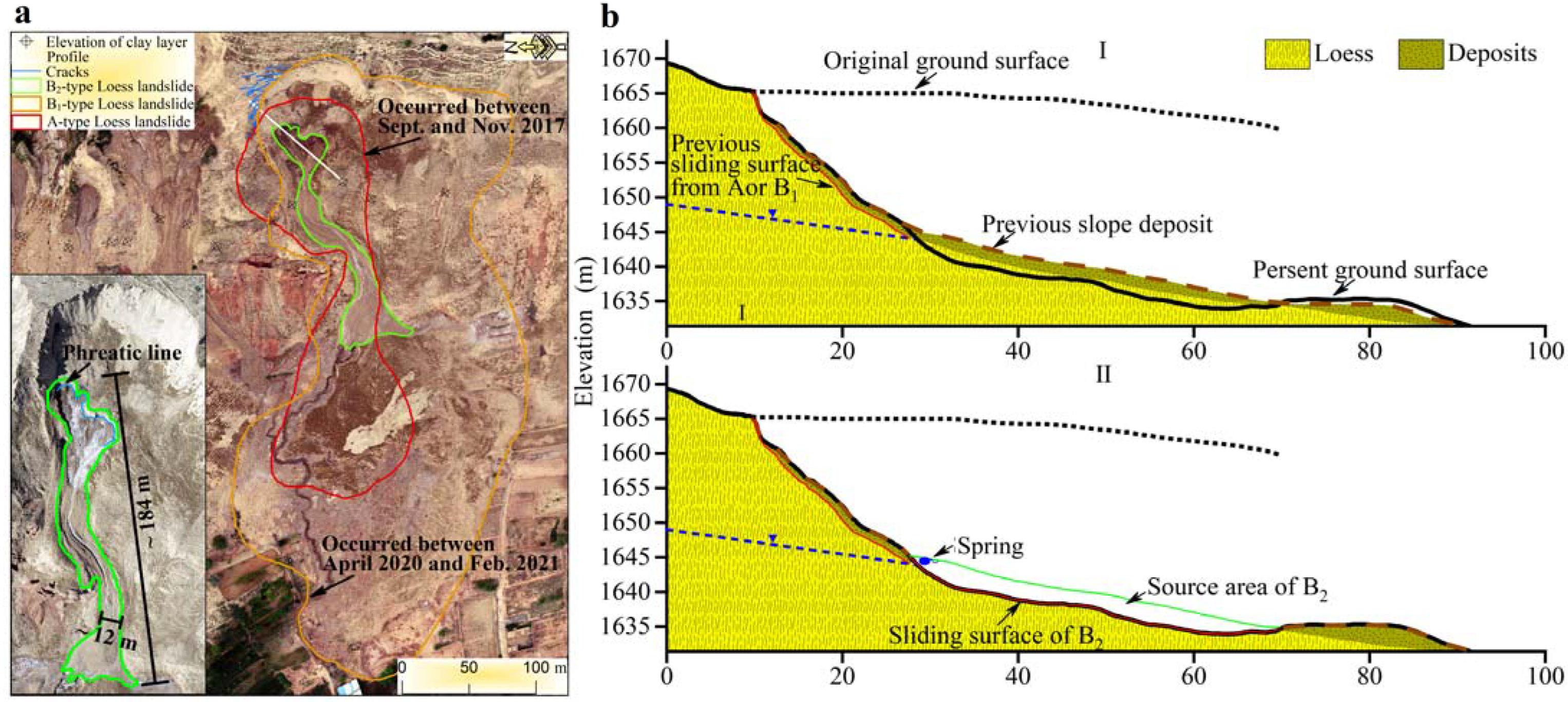
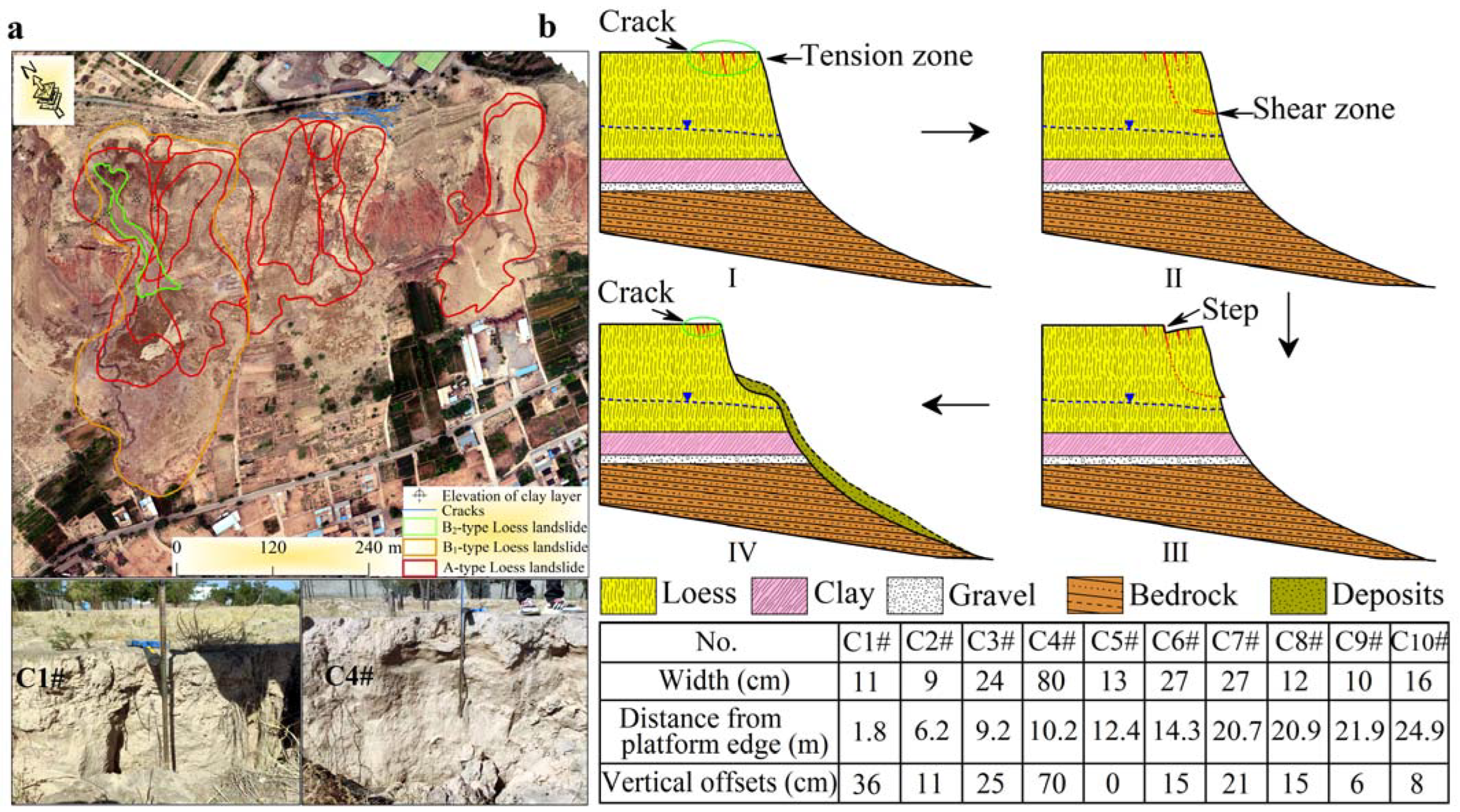
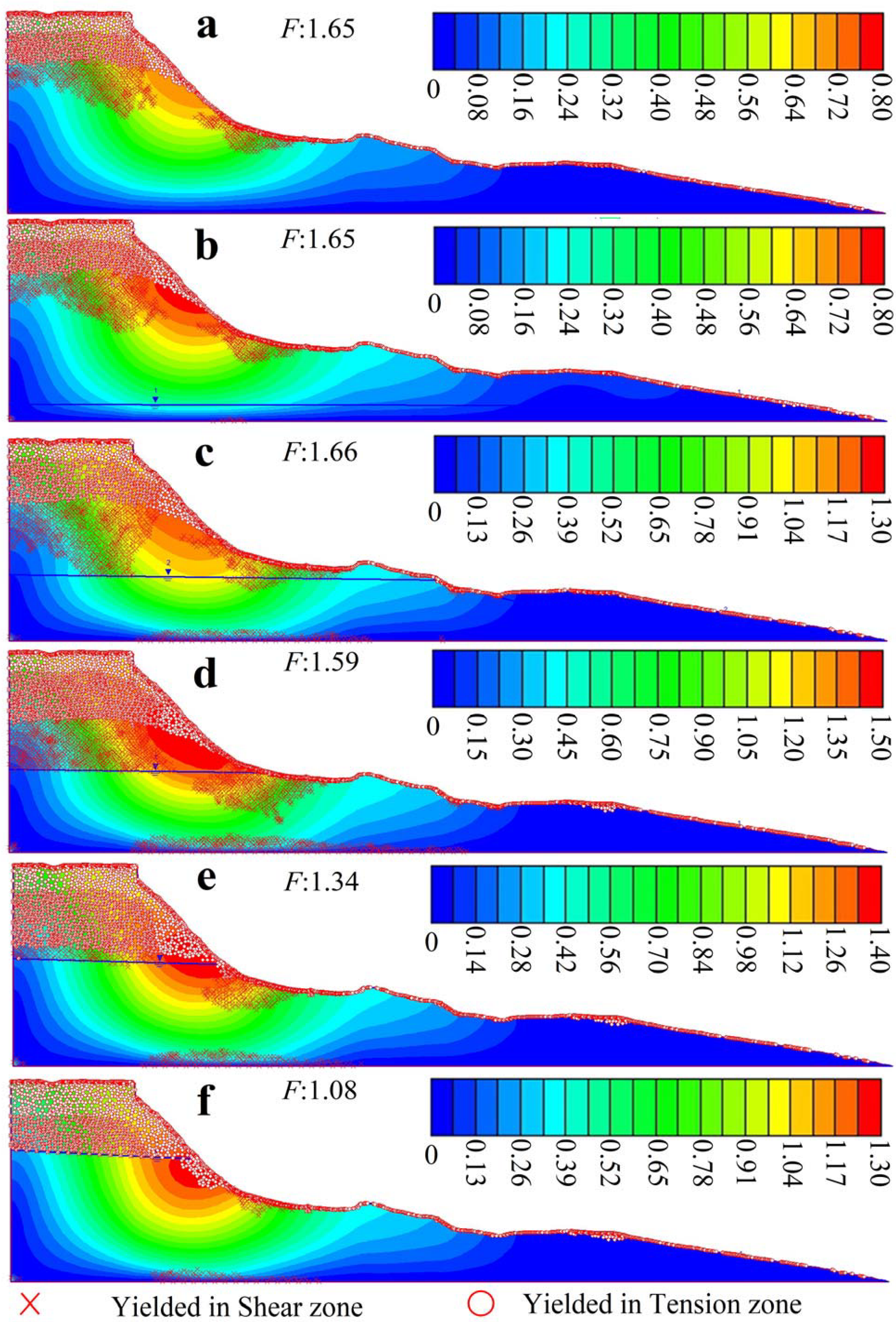

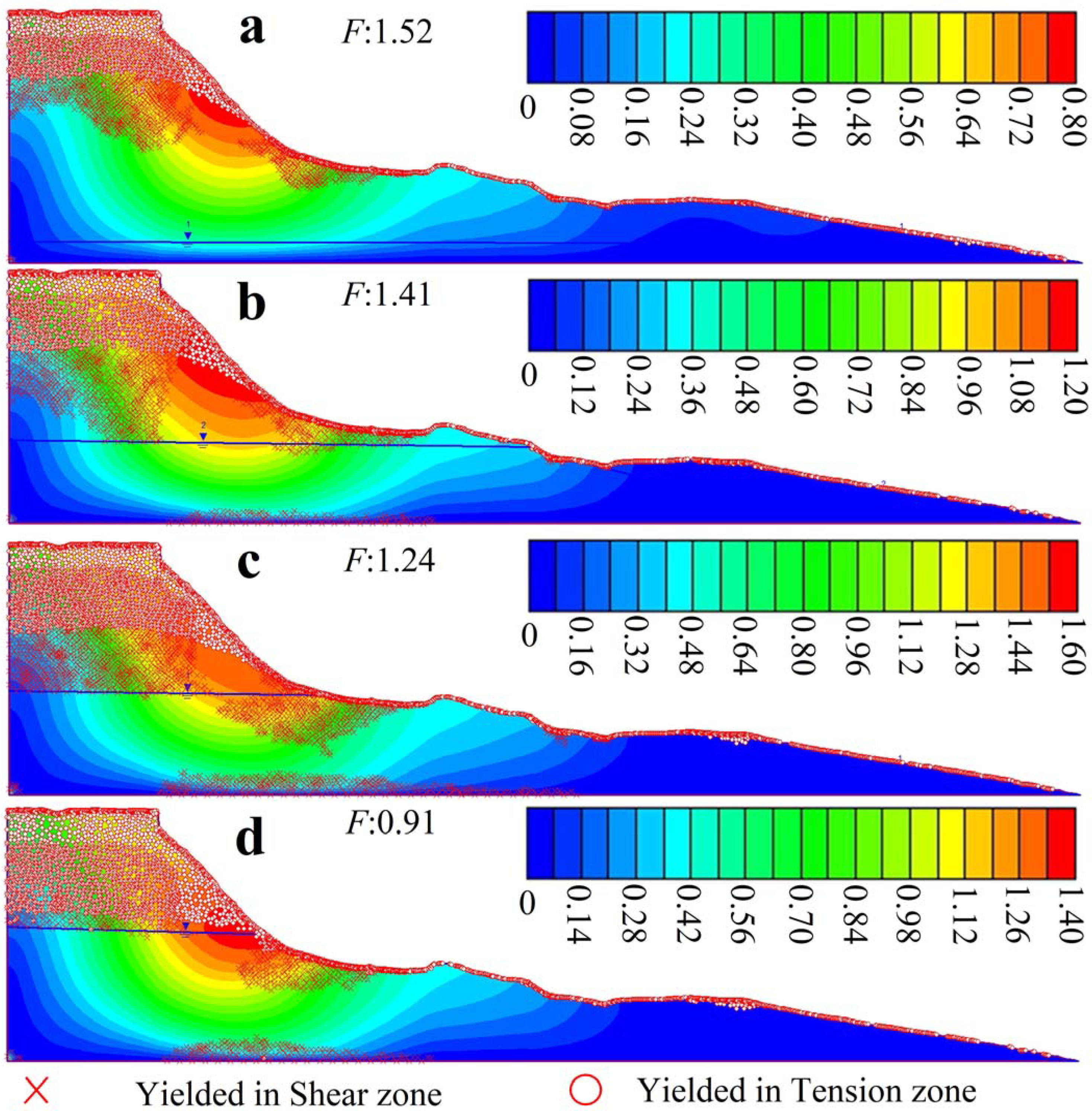

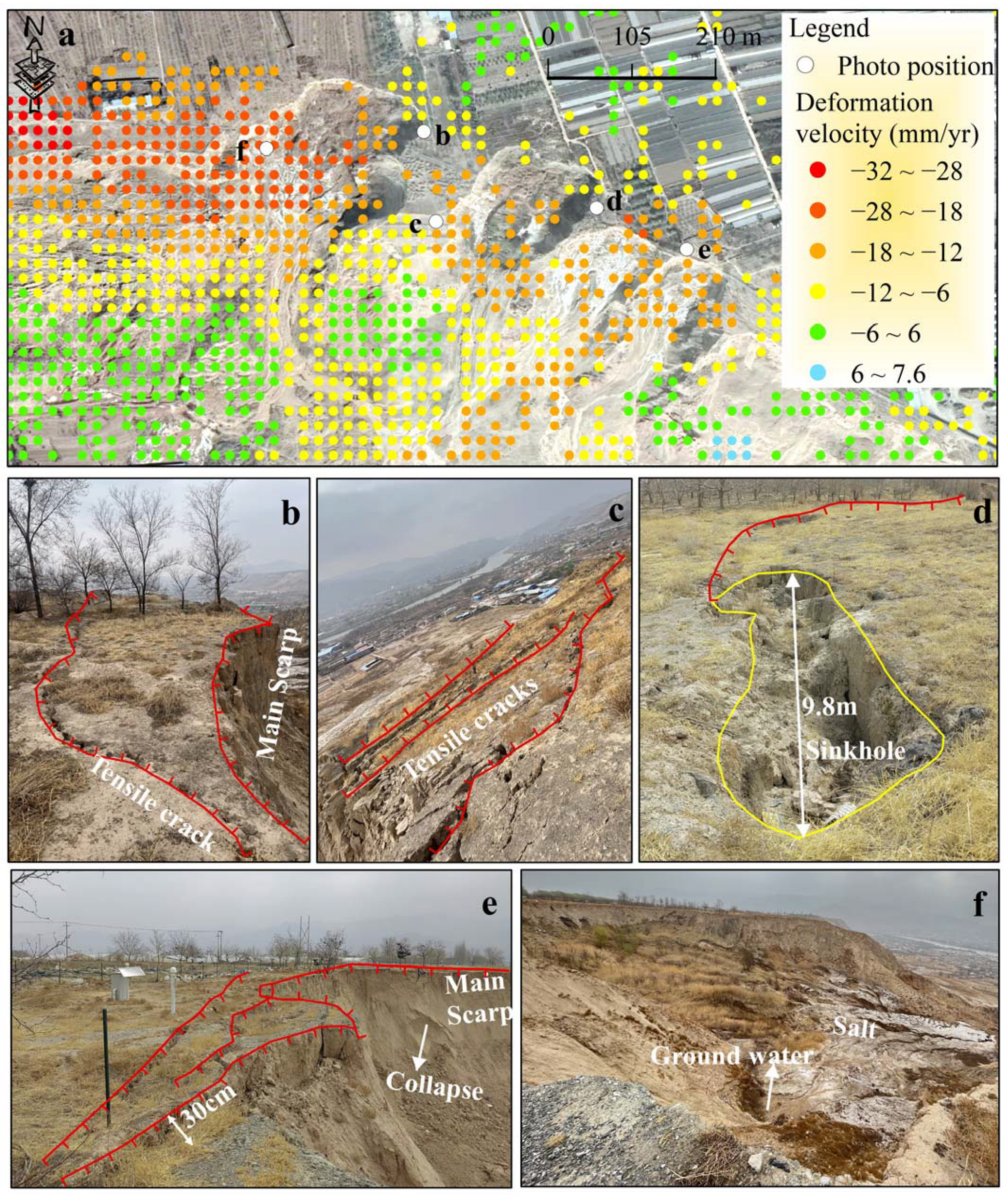
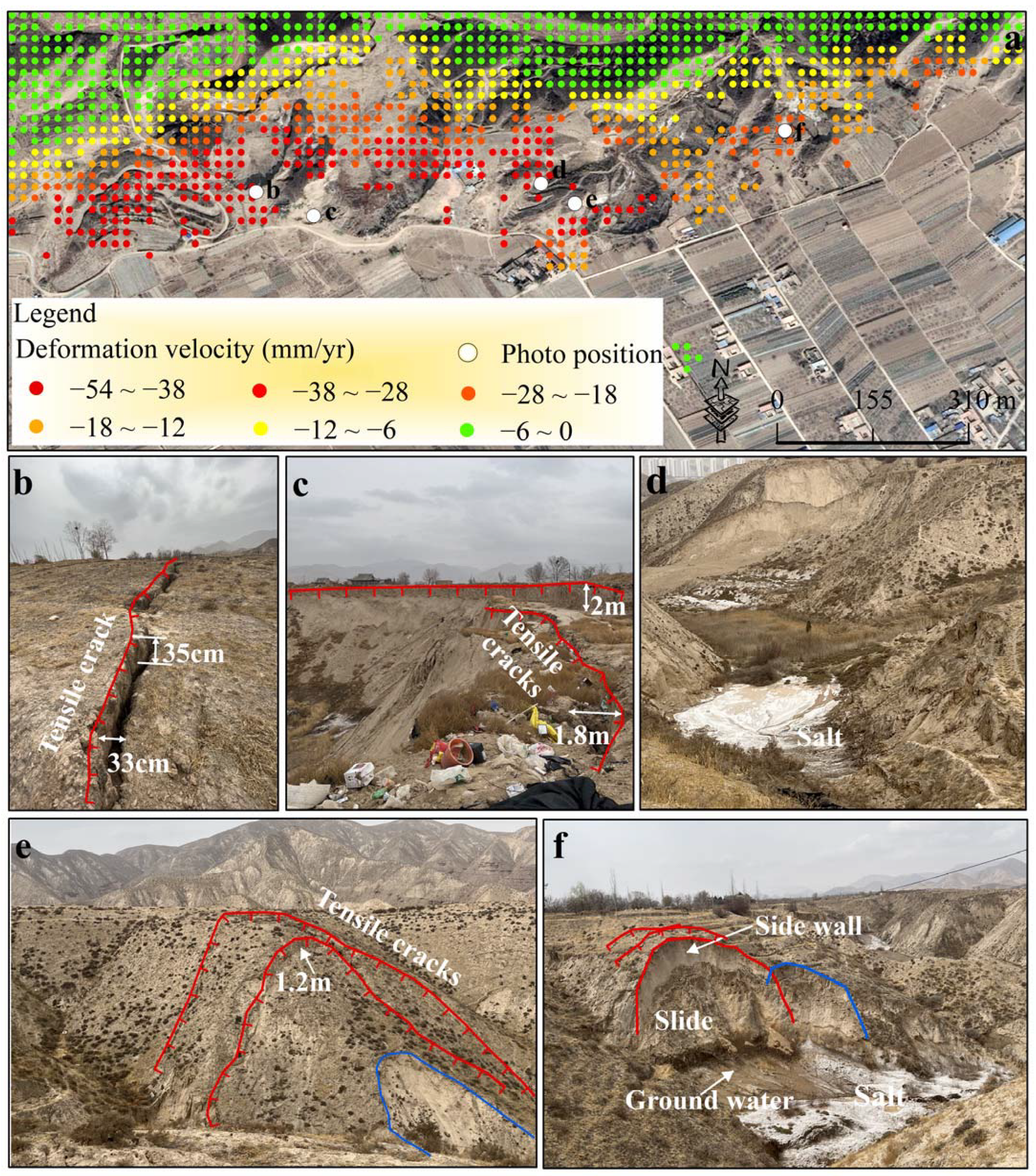
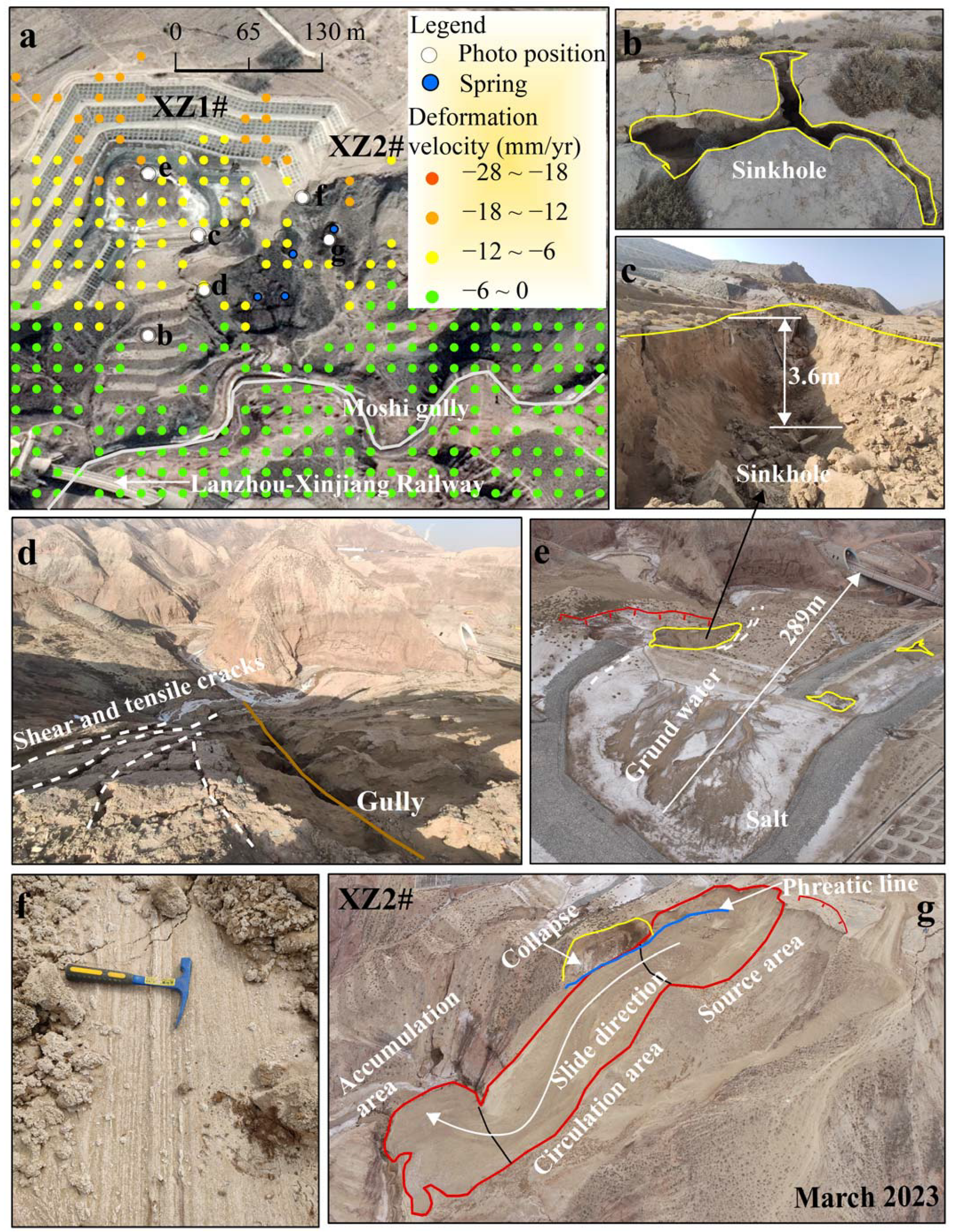
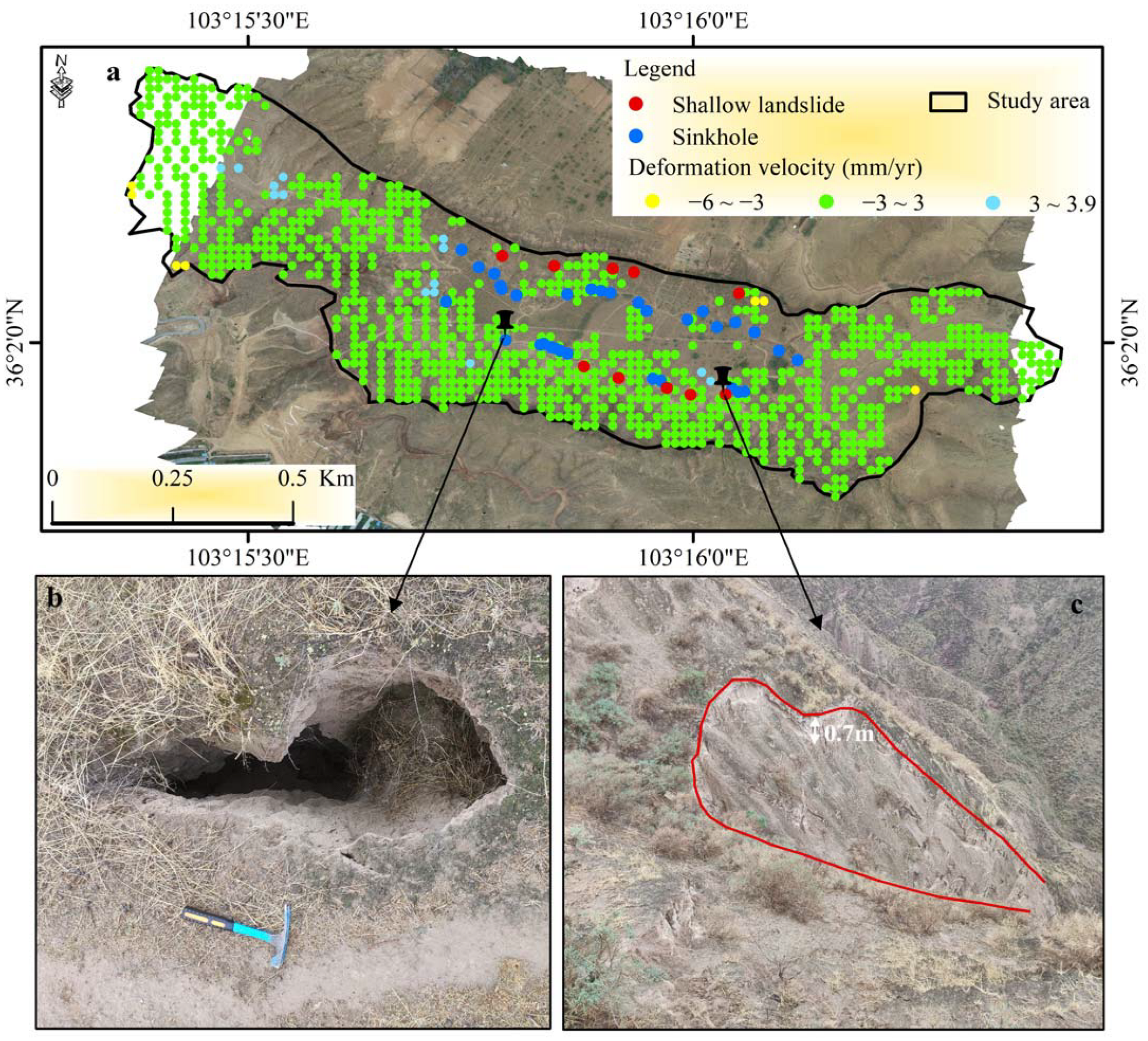

| No. | φp (°) | Cp (kPa) | φr (°) | Cr (kPa) | |
|---|---|---|---|---|---|
| Unsaturated Loess | 0 | 33.94 | 44.27 | 32.24 | 37.63 |
| 1 | 32.24 | 39.84 | 30.63 | 33.87 | |
| 2 | 30.63 | 35.86 | 29.10 | 30.48 | |
| 3 | 29.10 | 32.27 | 27.64 | 27.43 | |
| 4 | 27.64 | 29.05 | 26.26 | 24.69 | |
| Saturated Loess | 0 | 33.94 | 44.27 | 33.24 | 37.63 |
| 1 | 30.55 | 37.63 | 29.02 | 31.99 | |
| 2 | 27.49 | 31.99 | 26.12 | 27.19 | |
| 3 | 24.74 | 27.19 | 23.51 | 23.11 | |
| 4 | 22.27 | 23.11 | 21.15 | 19.64 |
| 24/05/2019 | 03/10/2020 | 08/11/2020 | 12/12/2020 | 17/01/2021 | 22/03/2021 | 25/04/2021 | 26/06/2021 | 25/08/2021 | 29/09/2021 | 01/12/2021 | 10/04/2023 |
|---|---|---|---|---|---|---|---|---|---|---|---|
| 23.40 | 22.90 | 22.88 | 22.81 | 22.84 | 22.91 | 22.94 | 22.79 | 22.87 | 22.82 | 22.95 | 23.49 |
Disclaimer/Publisher’s Note: The statements, opinions and data contained in all publications are solely those of the individual author(s) and contributor(s) and not of MDPI and/or the editor(s). MDPI and/or the editor(s) disclaim responsibility for any injury to people or property resulting from any ideas, methods, instructions or products referred to in the content. |
© 2023 by the authors. Licensee MDPI, Basel, Switzerland. This article is an open access article distributed under the terms and conditions of the Creative Commons Attribution (CC BY) license (https://creativecommons.org/licenses/by/4.0/).
Share and Cite
Zhang, Z.; Zeng, R.; Zhao, S.; Meng, X.; Ma, J.; Yin, H.; Long, Z. Effects of Irrigation Projects on the Classification of Yellow River Terrace Landslides and their Failure Modes: A Case Study of Heitai Terrace. Remote Sens. 2023, 15, 5012. https://doi.org/10.3390/rs15205012
Zhang Z, Zeng R, Zhao S, Meng X, Ma J, Yin H, Long Z. Effects of Irrigation Projects on the Classification of Yellow River Terrace Landslides and their Failure Modes: A Case Study of Heitai Terrace. Remote Sensing. 2023; 15(20):5012. https://doi.org/10.3390/rs15205012
Chicago/Turabian StyleZhang, Zonglin, Runqiang Zeng, Shufen Zhao, Xingmin Meng, Jianhua Ma, Hailong Yin, and Zhao Long. 2023. "Effects of Irrigation Projects on the Classification of Yellow River Terrace Landslides and their Failure Modes: A Case Study of Heitai Terrace" Remote Sensing 15, no. 20: 5012. https://doi.org/10.3390/rs15205012
APA StyleZhang, Z., Zeng, R., Zhao, S., Meng, X., Ma, J., Yin, H., & Long, Z. (2023). Effects of Irrigation Projects on the Classification of Yellow River Terrace Landslides and their Failure Modes: A Case Study of Heitai Terrace. Remote Sensing, 15(20), 5012. https://doi.org/10.3390/rs15205012







